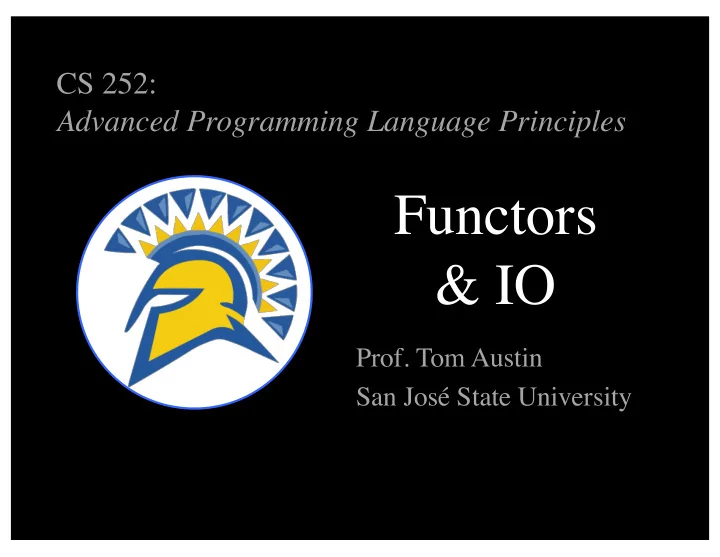

CS 252: Advanced Programming Language Principles Functors & IO Prof. Tom Austin San José State University
Review: Add 1 to each element in a list of numbers
The Functor typeclass class Functor f where fmap :: (a -> b) -> f a -> f b Compare fmap to map : map :: (a -> b) -> [a] -> [b]
A functor is something that can be mapped over.
Box analogy for functors
Maps as functors instance Functor [] where fmap = map
Prelude> map (+1) [1,2,3] [2,3,4] Prelude> fmap (+1) [1,2,3] [2,3,4] Prelude> fmap (+1) [] [] Prelude> fmap (+1) $ Just 3 Just 4 Prelude> fmap (+1) $ Nothing Nothing
Maybe as a functor instance Functor Maybe where fmap f (Just x) = Just (f x) fmap f Nothing = Nothing
Either type data Either a b = Left a | Right b deriving (Eq,Ord,Read,Show)
Prelude> fmap (+1) $ Right 20 Right 21 Prelude> fmap (+1) $ Left 20 Left 20 ???
Either type data Either a b = Left a | Right b deriving (Eq,Ord,Read,Show) Error type
Either type data Either a b = Left a | Right b deriving (Eq,Ord,Read,Show) Expected type
Either as a functor instance Functor (Either a) where fmap f (Right x) = Right (f x) fmap f (Left x) = Left x
Haskell Input/Output
Side effects & monads • Haskell avoids side effects – Inevitable in real programs • Monads – related to functors – used to compartmentalize side effects
Haskell Input/Output • Why does main have this type? main :: IO () • Why does getLine have this type? getLine :: IO String
Hello world in Haskell main = putStrLn "hello" We can call other functions that perform file I/O, but their type will also include an IO somewhere
Do syntax main = do putStrLn "Who goes there?" name <- getLine putStrLn $ "Welcome, " ++ name Pulling data out of an IO "box"
A more complex example main = do line <- getLine The unit type if null line then return () else do putStrLn $ reverseWords line main Ah! Something reverseWords = unwords . familiar. map reverse . words
No
Haskell's return : the single worst named keyword in any language ever made.
Haskell's return • unrelated to return in other languages • better names: "wrap" or "box": return puts a value in a "box" <- gets contents of a "box"
Haskell's return *Main> :t () () :: () *Main> :t (return ()) (return ()) :: Monad m => m () We'll come back to Monads later
Is Io a Functor ? main = do line <- fmap (++"!!!") getLine putStrLn line fmap appends the string " !!! " to the input from getLine .
Functor IO instance Functor IO where fmap f action = do Take the value out of its box result <- action return (f result) Apply f to result , then put the value back in the box
Functor Laws (or at least strong suggestions)
Functor Law #1 If we map the id function over a functor, the functor that we get back should be the same as the original functor. Prelude> fmap id (Just 3) Just 3 Prelude> fmap id Nothing Nothing Prelude> fmap id [1,2,3] [1,2,3]
Functor Law #2 Composing two functions and then mapping the resulting function over a functor should be the same as first mapping one function over the functor and then mapping the other one. More formally written: fmap (f . g) = fmap f . fmap g
The functor laws are not enforced, but they make your code easier to reason about.
Lab: Functors Add support for fmap to the Tree type. Download functors.lhs from the course website.
Recommend
More recommend